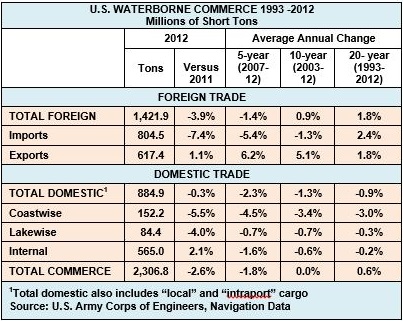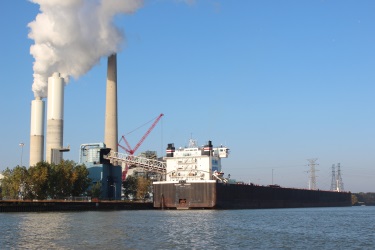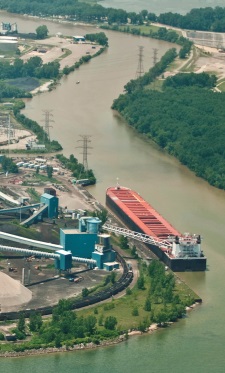
| March 11, 2014 | |
Cargo Statistics: U.S. Waterborne Trade, Monroe, Virginia
![]() Print this Article | Send to Colleague
Print this Article | Send to Colleague
America’s waterborne commerce fell in 2012 to 2.3 billion shop tons, a drop of 2.6 percent from the year before, according to data compiled and reported by the U.S. Army Corps of Engineers’ Waterborne Commerce Statistics Center. The 2013 Great Lakes/Seaway shipping season was a history maker for the Port of Monroe, where cargo reached an all-time high of nearly 2.2 million metric tons. The Virginia Port Authority (VPA) reports container traffic growth continued into January at its Hampton Roads marine terminals.
U.S. Waterborne Trade 2012: Record Exports, Total Tonnage Down
America’s waterborne commerce fell in 2012, with total volume down 2.6 percent from the year before to just over 2.3 billion short tons, according to data compiled and reported by the U.S. Army Corps of Engineers’ Waterborne Commerce Statistics Center in New Orleans. The reduced figure followed two consecutive years of growth but remained ahead of the 2.2 billion tons posted in the recessionary year of 2009. Total tonnage includes foreign trade (i.e., import/export) and domestic cargo shipped between and within U.S. coastal, Great Lakes and inland waterway ports.
Exports set a record for the third year in a row, up 1.1 percent from 2011 to 617 million tons. Imports continued to lose ground, falling 7.4 percent to a 14-year low of 804.5 million tons. Among the domestic trades, declines in coastwise and Great Lakes cargo offset a 2.1 percent increase by inland waterway freight movements. The long-term trend remained negative for America’s domestic waterway trade, especially the coastwise segment.

Based on total tonnage, the top-ranked U.S. ports in 2012 were South Louisiana, Houston, New York/New Jersey, New Orleans and Beaumont. South Louisiana also ranked first in domestic cargo and foreign exports, while Houston led the nation in imports and total foreign trade. Duluth/Superior stood first among U.S. Great Lakes ports. Huntington on the Ohio River was the leading shallow-draft, inland waterway port. The attachment presents the Top 35 port rankings based on domestic, foreign and total cargo tonnage.
Monroe Record Cargo Tonnage in 2013, Further Growth Anticipated
Monroe Record Cargo Tonnage in 2013, Further Growth Anticipated
The 2013 Great Lakes/Seaway shipping season was a history maker for the Port of Monroe, with cargo at an all-time high of nearly 2.2 million metric tons.
"In 2013, we had 97 vessel calls: 81 to DTE Energy’s Monroe Power Plant carrying bulk, three carrying project cargo (two of which were Seaway tonnage) and 13 liquid asphalt cargoes to Michigan Paving & Materials," said Port Director Paul C. LaMarre.
Looking ahead to the 2014 season, LaMarre anticipates "significant tonnage increases as we develop multiple new outbound cargoes with DTE Energy – the most significant of which will be synthetic gypsum produced by the Monroe Power Plant’s new scrubbing units."
The ability to receive materials and equipment by vessel is critical for the continued operation of tenant Monroe Power Plant. The plant requires approximately 8.5 million tons of coal per year, and one-third of that volume is delivered by ship.
"During the last 10 years, we have relied on vessels to deliver most of the modular components to be used in the construction of emissions control systems that are making the Monroe Power Plant one of the cleanest operating coal plants in the country," explained Andrew S. Dobrzanski, the plant’s manager of fuel supply.

Self-discharging bulk carrier Indiana Harbor delivering coat to DTE Energy’s Monroe Power Plant.
Photo/Port of Monroe
Onsite developments at the Lake Erie port include a 23-acre general cargo facility, which will have 3,000 feet of waterfront and double-track rail on what will know as the port’s "Riverfront Dock." The port will also be installing a rail spur into tenant Ventower Industries, which is now operating at full capacity.


Overhead view of Monroe’s working waterfront.
Photo/Port of Monroe
Virginia Container Traffic Up 5.4 Percent in January
The Virginia Port Authority (VPA) reports container traffic growth at its Hampton Roads marine terminals continued into January. Volume overall at 167,272 TEUs was up 5.4 percent from January, reflecting increases of 7 percent and 3.5 percent, respectively, for exports and imports. The solid January numbers follow the record 2,223,532 TEUs set in CY 2013.
The VPA also reported year-on-year increases of 10.3 percent in containerized cargo tonnage, 14 percent for containers handled at its inland port near Front Royal (VA) and 8 percent for containers shipped in and out of its Hampton Roads terminals by rail.
"We had forecast growth in 2014 and in the first month our volume exceeded our forecast," said John F. Reinhart, the VPA’s CEO and executive director. "We’re strong on the export side because the ocean carriers are taking advantage of Virginia’s deep water and loading heavy on the out-bound leg of their journey."
Furthermore, he said: "We expect the carriers to take even greater advantage of that asset as the bigger vessels get introduced into service. As that happens, this port is going to grow, so we are going to have to become more efficient. We are discussing this very issue – efficiency – right now internally and with our rail, motor carrier, ILA and ocean carrier partners."
